window NISSAN PATHFINDER HYBRID 2014 R52 / 4.G Owners Manual
[x] Cancel search | Manufacturer: NISSAN, Model Year: 2014, Model line: PATHFINDER HYBRID, Model: NISSAN PATHFINDER HYBRID 2014 R52 / 4.GPages: 571, PDF Size: 5.38 MB
Page 17 of 571
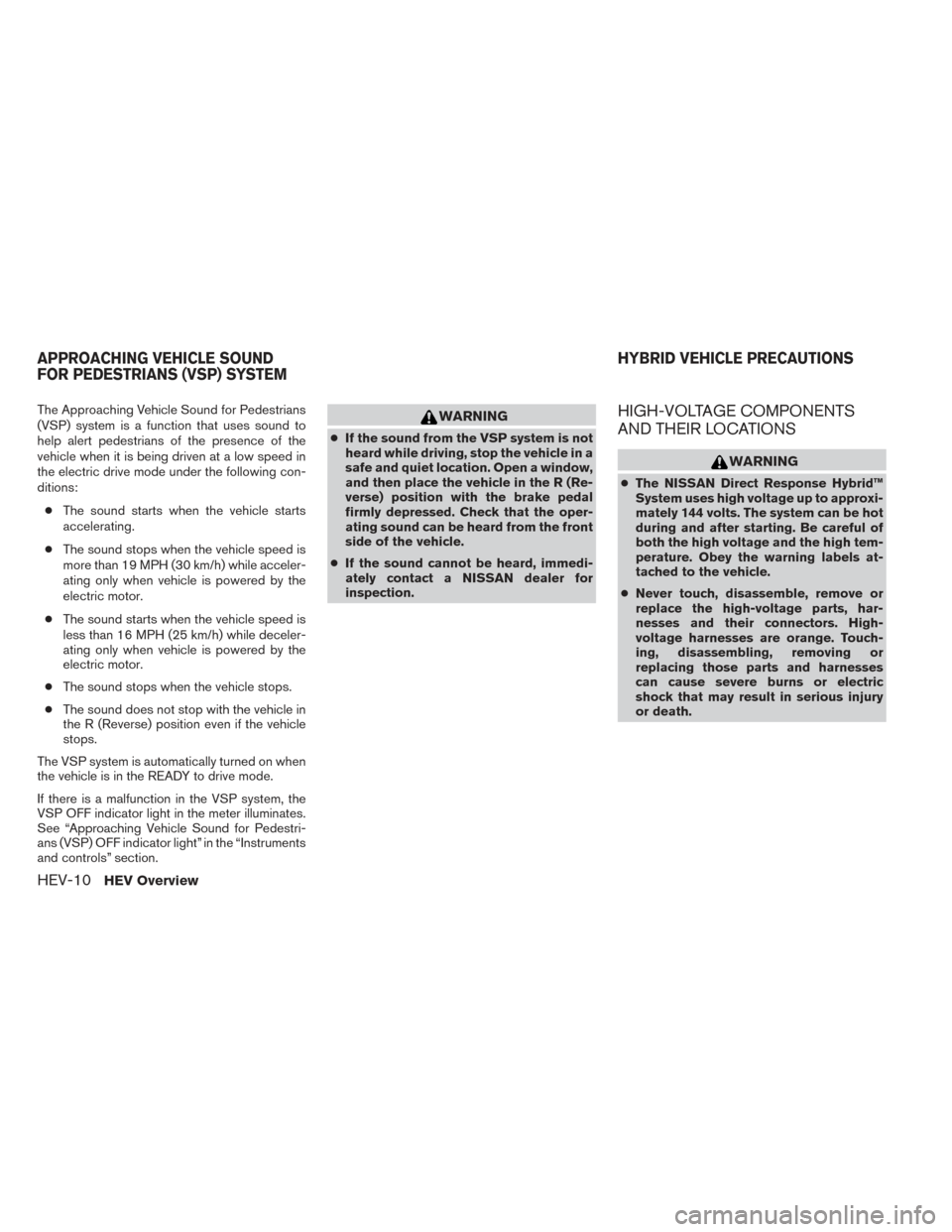
The Approaching Vehicle Sound for Pedestrians
(VSP) system is a function that uses sound to
help alert pedestrians of the presence of the
vehicle when it is being driven at a low speed in
the electric drive mode under the following con-
ditions:● The sound starts when the vehicle starts
accelerating.
● The sound stops when the vehicle speed is
more than 19 MPH (30 km/h) while acceler-
ating only when vehicle is powered by the
electric motor.
● The sound starts when the vehicle speed is
less than 16 MPH (25 km/h) while deceler-
ating only when vehicle is powered by the
electric motor.
● The sound stops when the vehicle stops.
● The sound does not stop with the vehicle in
the R (Reverse) position even if the vehicle
stops.
The VSP system is automatically turned on when
the vehicle is in the READY to drive mode.
If there is a malfunction in the VSP system, the
VSP OFF indicator light in the meter illuminates.
See “Approaching Vehicle Sound for Pedestri-
ans (VSP) OFF indicator light” in the “Instruments
and controls” section.WARNING
● If the sound from the VSP system is not
heard while driving, stop the vehicle in a
safe and quiet location. Open a window,
and then place the vehicle in the R (Re-
verse) position with the brake pedal
firmly depressed. Check that the oper-
ating sound can be heard from the front
side of the vehicle.
● If the sound cannot be heard, immedi-
ately contact a NISSAN dealer for
inspection.
HIGH-VOLTAGE COMPONENTS
AND THEIR LOCATIONS
WARNING
● The NISSAN Direct Response Hybrid™
System uses high voltage up to approxi-
mately 144 volts. The system can be hot
during and after starting. Be careful of
both the high voltage and the high tem-
perature. Obey the warning labels at-
tached to the vehicle.
● Never touch, disassemble, remove or
replace the high-voltage parts, har-
nesses and their connectors. High-
voltage harnesses are orange. Touch-
ing, disassembling, removing or
replacing those parts and harnesses
can cause severe burns or electric
shock that may result in serious injury
or death.
APPROACHING VEHICLE SOUND
FOR PEDESTRIANS (VSP) SYSTEM HYBRID VEHICLE PRECAUTIONS
HEV-10HEV Overview
Page 42 of 571
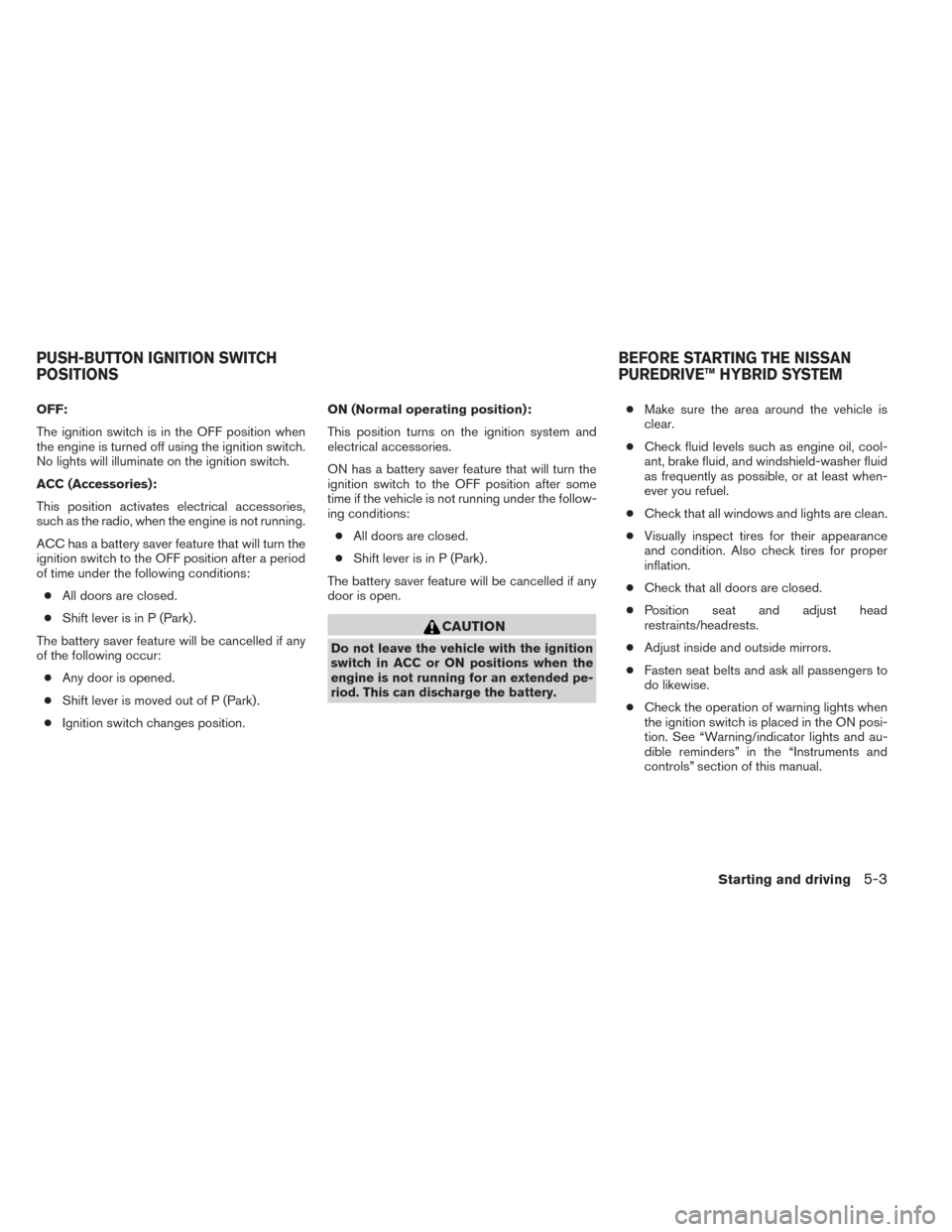
OFF:
The ignition switch is in the OFF position when
the engine is turned off using the ignition switch.
No lights will illuminate on the ignition switch.
ACC (Accessories):
This position activates electrical accessories,
such as the radio, when the engine is not running.
ACC has a battery saver feature that will turn the
ignition switch to the OFF position after a period
of time under the following conditions:● All doors are closed.
● Shift lever is in P (Park) .
The battery saver feature will be cancelled if any
of the following occur: ● Any door is opened.
● Shift lever is moved out of P (Park) .
● Ignition switch changes position. ON (Normal operating position):
This position turns on the ignition system and
electrical accessories.
ON has a battery saver feature that will turn the
ignition switch to the OFF position after some
time if the vehicle is not running under the follow-
ing conditions:
● All doors are closed.
● Shift lever is in P (Park) .
The battery saver feature will be cancelled if any
door is open.
CAUTION
Do not leave the vehicle with the ignition
switch in ACC or ON positions when the
engine is not running for an extended pe-
riod. This can discharge the battery. ●
Make sure the area around the vehicle is
clear.
● Check fluid levels such as engine oil, cool-
ant, brake fluid, and windshield-washer fluid
as frequently as possible, or at least when-
ever you refuel.
● Check that all windows and lights are clean.
● Visually inspect tires for their appearance
and condition. Also check tires for proper
inflation.
● Check that all doors are closed.
● Position seat and adjust head
restraints/headrests.
● Adjust inside and outside mirrors.
● Fasten seat belts and ask all passengers to
do likewise.
● Check the operation of warning lights when
the ignition switch is placed in the ON posi-
tion. See “Warning/indicator lights and au-
dible reminders” in the “Instruments and
controls” section of this manual.
PUSH-BUTTON IGNITION SWITCH
POSITIONS BEFORE STARTING THE NISSAN
PUREDRIVE™ HYBRID SYSTEM
Starting and driving5-3
Page 44 of 571
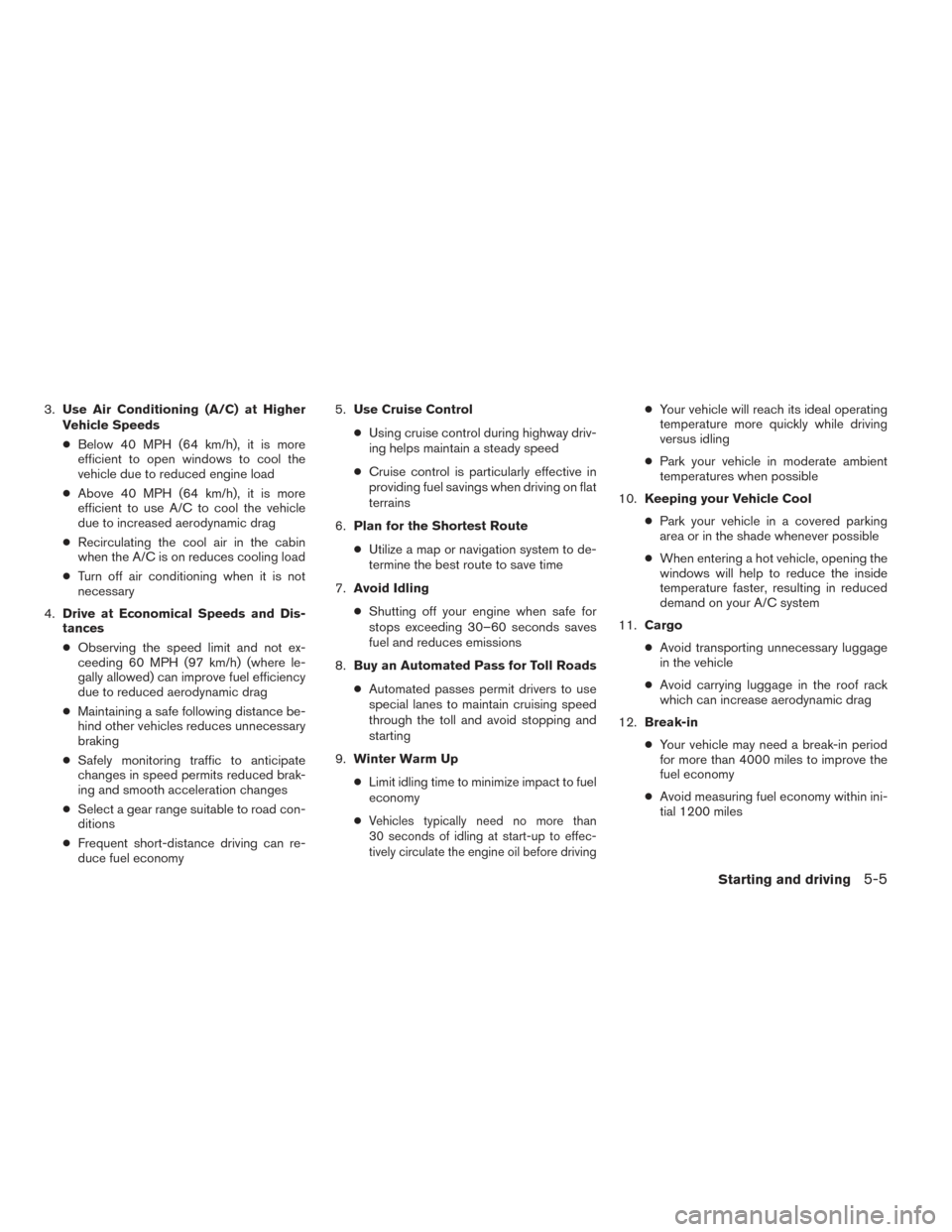
3.Use Air Conditioning (A/C) at Higher
Vehicle Speeds
● Below 40 MPH (64 km/h), it is more
efficient to open windows to cool the
vehicle due to reduced engine load
● Above 40 MPH (64 km/h), it is more
efficient to use A/C to cool the vehicle
due to increased aerodynamic drag
● Recirculating the cool air in the cabin
when the A/C is on reduces cooling load
● Turn off air conditioning when it is not
necessary
4. Drive at Economical Speeds and Dis-
tances
● Observing the speed limit and not ex-
ceeding 60 MPH (97 km/h) (where le-
gally allowed) can improve fuel efficiency
due to reduced aerodynamic drag
● Maintaining a safe following distance be-
hind other vehicles reduces unnecessary
braking
● Safely monitoring traffic to anticipate
changes in speed permits reduced brak-
ing and smooth acceleration changes
● Select a gear range suitable to road con-
ditions
● Frequent short-distance driving can re-
duce fuel economy 5.
Use Cruise Control
● Using cruise control during highway driv-
ing helps maintain a steady speed
● Cruise control is particularly effective in
providing fuel savings when driving on flat
terrains
6. Plan for the Shortest Route
● Utilize a map or navigation system to de-
termine the best route to save time
7. Avoid Idling
● Shutting off your engine when safe for
stops exceeding 30–60 seconds saves
fuel and reduces emissions
8. Buy an Automated Pass for Toll Roads
● Automated passes permit drivers to use
special lanes to maintain cruising speed
through the toll and avoid stopping and
starting
9. Winter Warm Up
● Limit idling time to minimize impact to fuel
economy
●
Vehicles typically need no more than
30 seconds of idling at start-up to effec-
tively circulate the engine oil before driving
● Your vehicle will reach its ideal operating
temperature more quickly while driving
versus idling
● Park your vehicle in moderate ambient
temperatures when possible
10. Keeping your Vehicle Cool
● Park your vehicle in a covered parking
area or in the shade whenever possible
● When entering a hot vehicle, opening the
windows will help to reduce the inside
temperature faster, resulting in reduced
demand on your A/C system
11. Cargo
● Avoid transporting unnecessary luggage
in the vehicle
● Avoid carrying luggage in the roof rack
which can increase aerodynamic drag
12. Break-in
● Your vehicle may need a break-in period
for more than 4000 miles to improve the
fuel economy
● Avoid measuring fuel economy within ini-
tial 1200 miles
Starting and driving5-5
Page 52 of 571
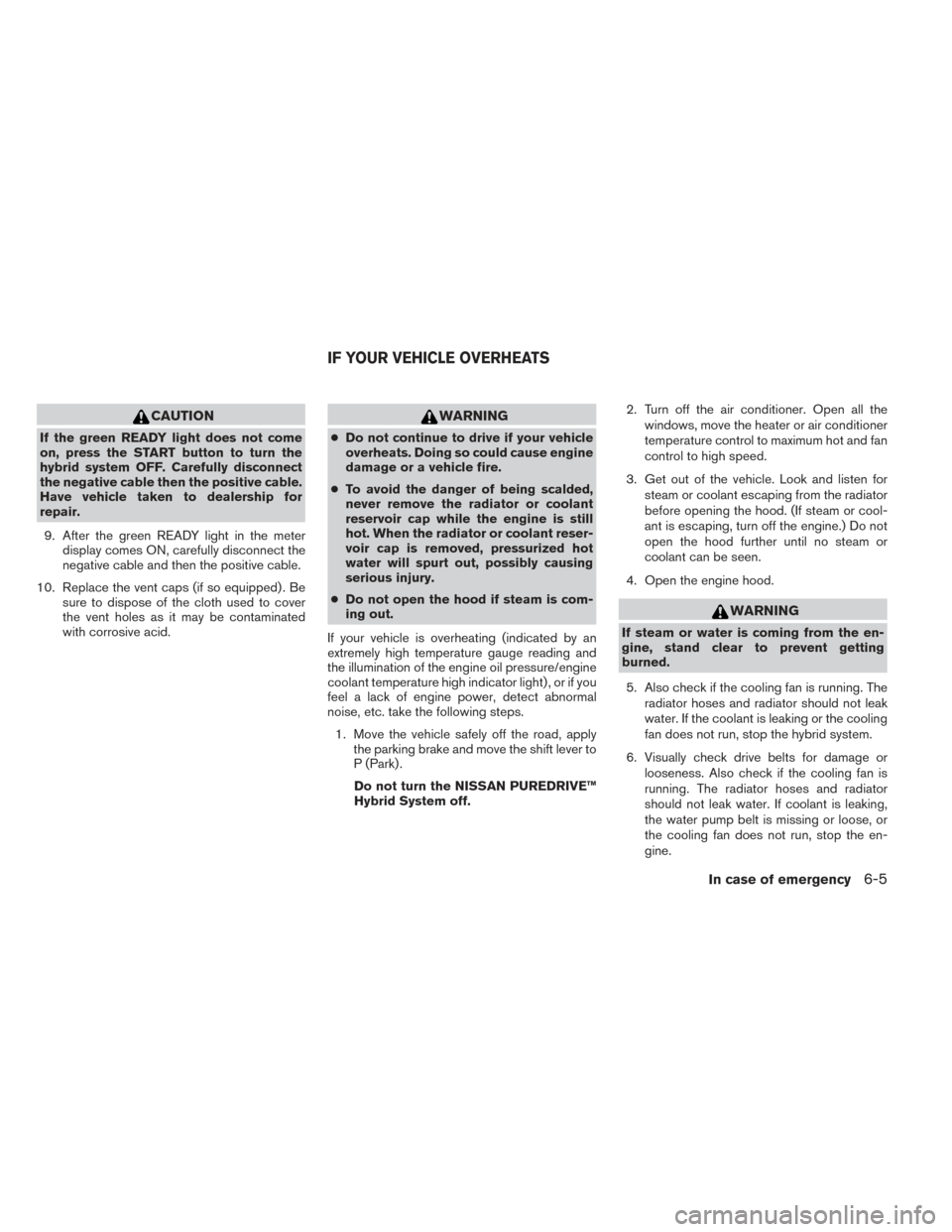
CAUTION
If the green READY light does not come
on, press the START button to turn the
hybrid system OFF. Carefully disconnect
the negative cable then the positive cable.
Have vehicle taken to dealership for
repair.9. After the green READY light in the meter display comes ON, carefully disconnect the
negative cable and then the positive cable.
10. Replace the vent caps (if so equipped) . Be sure to dispose of the cloth used to cover
the vent holes as it may be contaminated
with corrosive acid.
WARNING
●Do not continue to drive if your vehicle
overheats. Doing so could cause engine
damage or a vehicle fire.
● To avoid the danger of being scalded,
never remove the radiator or coolant
reservoir cap while the engine is still
hot. When the radiator or coolant reser-
voir cap is removed, pressurized hot
water will spurt out, possibly causing
serious injury.
● Do not open the hood if steam is com-
ing out.
If your vehicle is overheating (indicated by an
extremely high temperature gauge reading and
the illumination of the engine oil pressure/engine
coolant temperature high indicator light) , or if you
feel a lack of engine power, detect abnormal
noise, etc. take the following steps. 1. Move the vehicle safely off the road, apply the parking brake and move the shift lever to
P (Park) .
Do not turn the NISSAN PUREDRIVE™
Hybrid System off. 2. Turn off the air conditioner. Open all the
windows, move the heater or air conditioner
temperature control to maximum hot and fan
control to high speed.
3. Get out of the vehicle. Look and listen for steam or coolant escaping from the radiator
before opening the hood. (If steam or cool-
ant is escaping, turn off the engine.) Do not
open the hood further until no steam or
coolant can be seen.
4. Open the engine hood.
WARNING
If steam or water is coming from the en-
gine, stand clear to prevent getting
burned.
5. Also check if the cooling fan is running. The radiator hoses and radiator should not leak
water. If the coolant is leaking or the cooling
fan does not run, stop the hybrid system.
6. Visually check drive belts for damage or looseness. Also check if the cooling fan is
running. The radiator hoses and radiator
should not leak water. If coolant is leaking,
the water pump belt is missing or loose, or
the cooling fan does not run, stop the en-
gine.
IF YOUR VEHICLE OVERHEATS
In case of emergency6-5
Page 89 of 571
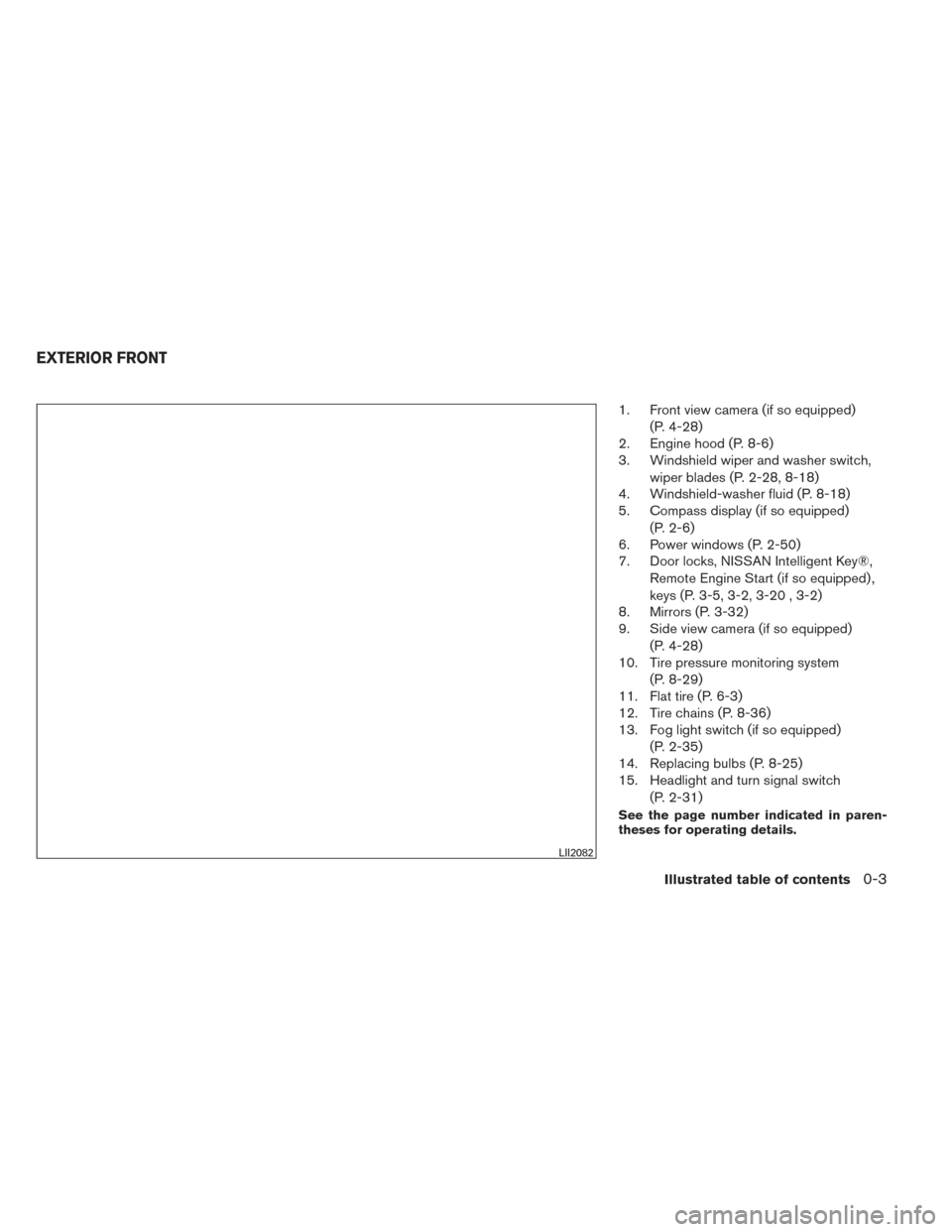
1. Front view camera (if so equipped)(P. 4-28)
2. Engine hood (P. 8-6)
3. Windshield wiper and washer switch,
wiper blades (P. 2-28, 8-18)
4. Windshield-washer fluid (P. 8-18)
5. Compass display (if so equipped)
(P. 2-6)
6. Power windows (P. 2-50)
7. Door locks, NISSAN Intelligent Key®,
Remote Engine Start (if so equipped) ,
keys (P. 3-5, 3-2, 3-20 , 3-2)
8. Mirrors (P. 3-32)
9. Side view camera (if so equipped)
(P. 4-28)
10. Tire pressure monitoring system
(P. 8-29)
11. Flat tire (P. 6-3)
12. Tire chains (P. 8-36)
13. Fog light switch (if so equipped)
(P. 2-35)
14. Replacing bulbs (P. 8-25)
15. Headlight and turn signal switch
(P. 2-31)
See the page number indicated in paren-
theses for operating details.
LII2082
EXTERIOR FRONT
Illustrated table of contents0-3
Page 90 of 571
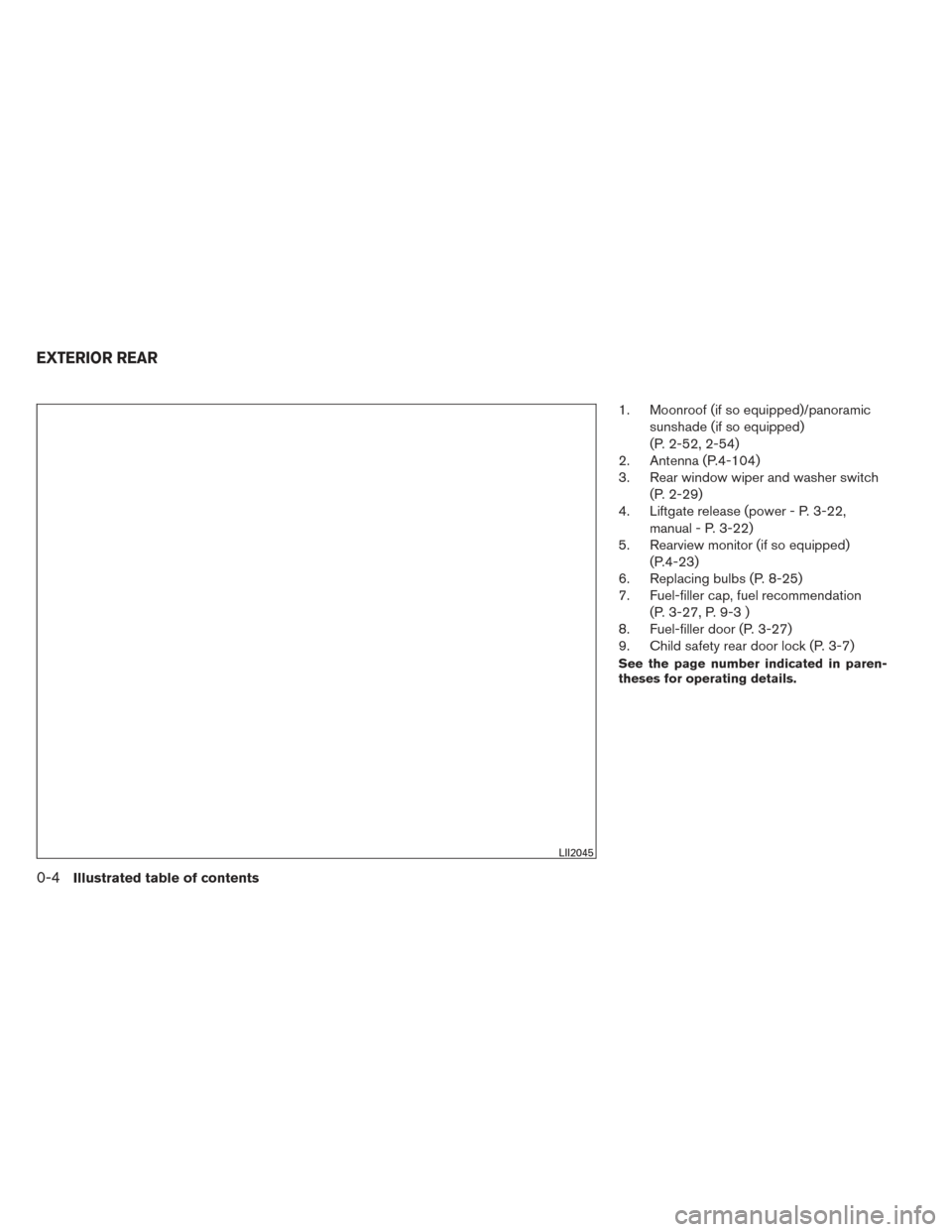
1. Moonroof (if so equipped)/panoramicsunshade (if so equipped)
(P. 2-52, 2-54)
2. Antenna (P.4-104)
3. Rear window wiper and washer switch
(P. 2-29)
4. Liftgate release (power - P. 3-22,
manual - P. 3-22)
5. Rearview monitor (if so equipped)
(P.4-23)
6. Replacing bulbs (P. 8-25)
7. Fuel-filler cap, fuel recommendation
(P. 3-27, P. 9-3 )
8. Fuel-filler door (P. 3-27)
9. Child safety rear door lock (P. 3-7)
See the page number indicated in paren-
theses for operating details.
LII2045
EXTERIOR REAR
0-4Illustrated table of contents
Page 92 of 571
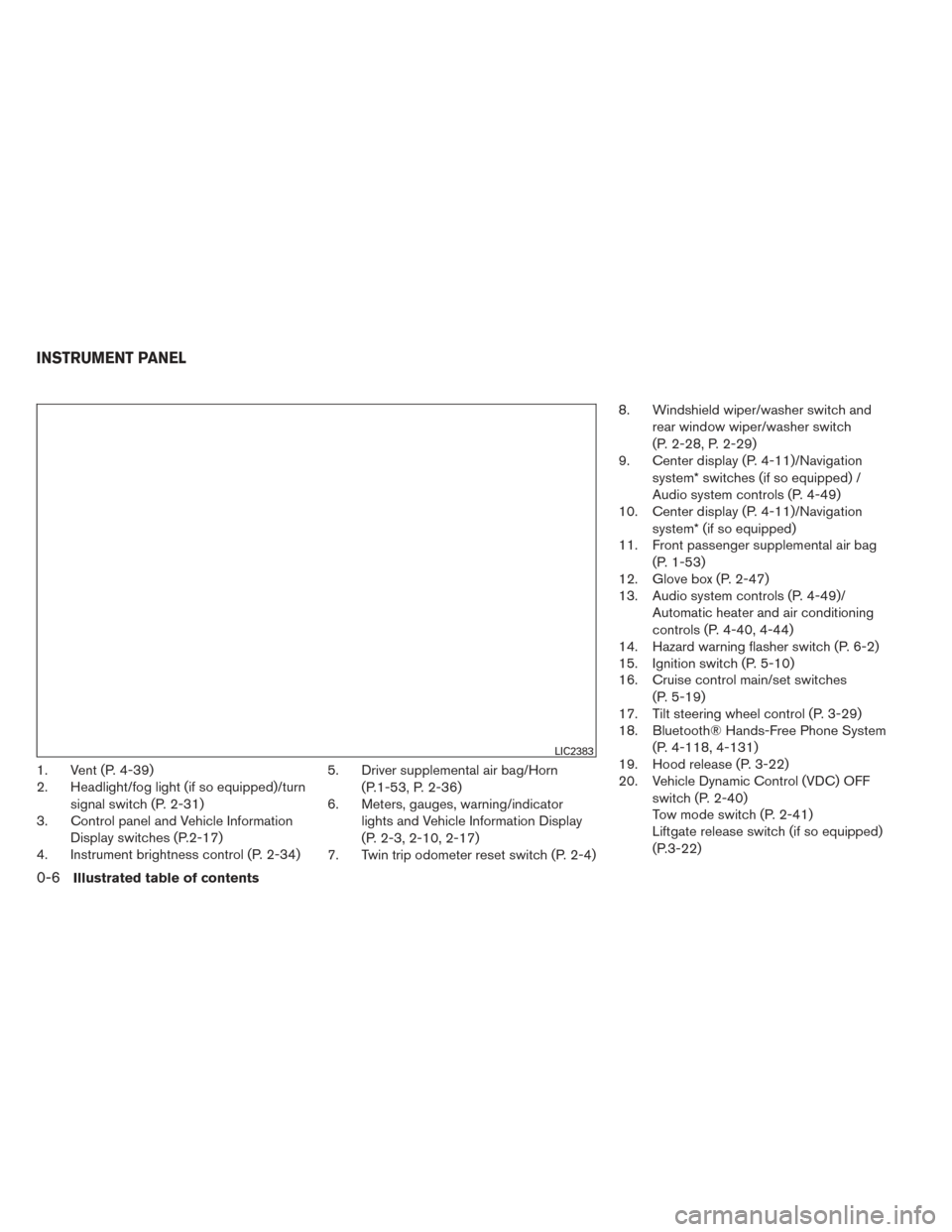
1. Vent (P. 4-39)
2. Headlight/fog light (if so equipped)/turnsignal switch (P. 2-31)
3. Control panel and Vehicle Information
Display switches (P.2-17)
4. Instrument brightness control (P. 2-34) 5. Driver supplemental air bag/Horn
(P.1-53, P. 2-36)
6. Meters, gauges, warning/indicator
lights and Vehicle Information Display
(P. 2-3, 2-10, 2-17)
7. Twin trip odometer reset switch (P. 2-4) 8. Windshield wiper/washer switch and
rear window wiper/washer switch
(P. 2-28, P. 2-29)
9. Center display (P. 4-11)/Navigation
system* switches (if so equipped) /
Audio system controls (P. 4-49)
10. Center display (P. 4-11)/Navigation
system* (if so equipped)
11. Front passenger supplemental air bag
(P. 1-53)
12. Glove box (P. 2-47)
13. Audio system controls (P. 4-49)/
Automatic heater and air conditioning
controls (P. 4-40, 4-44)
14. Hazard warning flasher switch (P. 6-2)
15. Ignition switch (P. 5-10)
16. Cruise control main/set switches
(P. 5-19)
17. Tilt steering wheel control (P. 3-29)
18. Bluetooth® Hands-Free Phone System
(P. 4-118, 4-131)
19. Hood release (P. 3-22)
20. Vehicle Dynamic Control (VDC) OFF
switch (P. 2-40)
Tow mode switch (P. 2-41)
Liftgate release switch (if so equipped)
(P.3-22)
LIC2383
INSTRUMENT PANEL
0-6Illustrated table of contents
Page 151 of 571
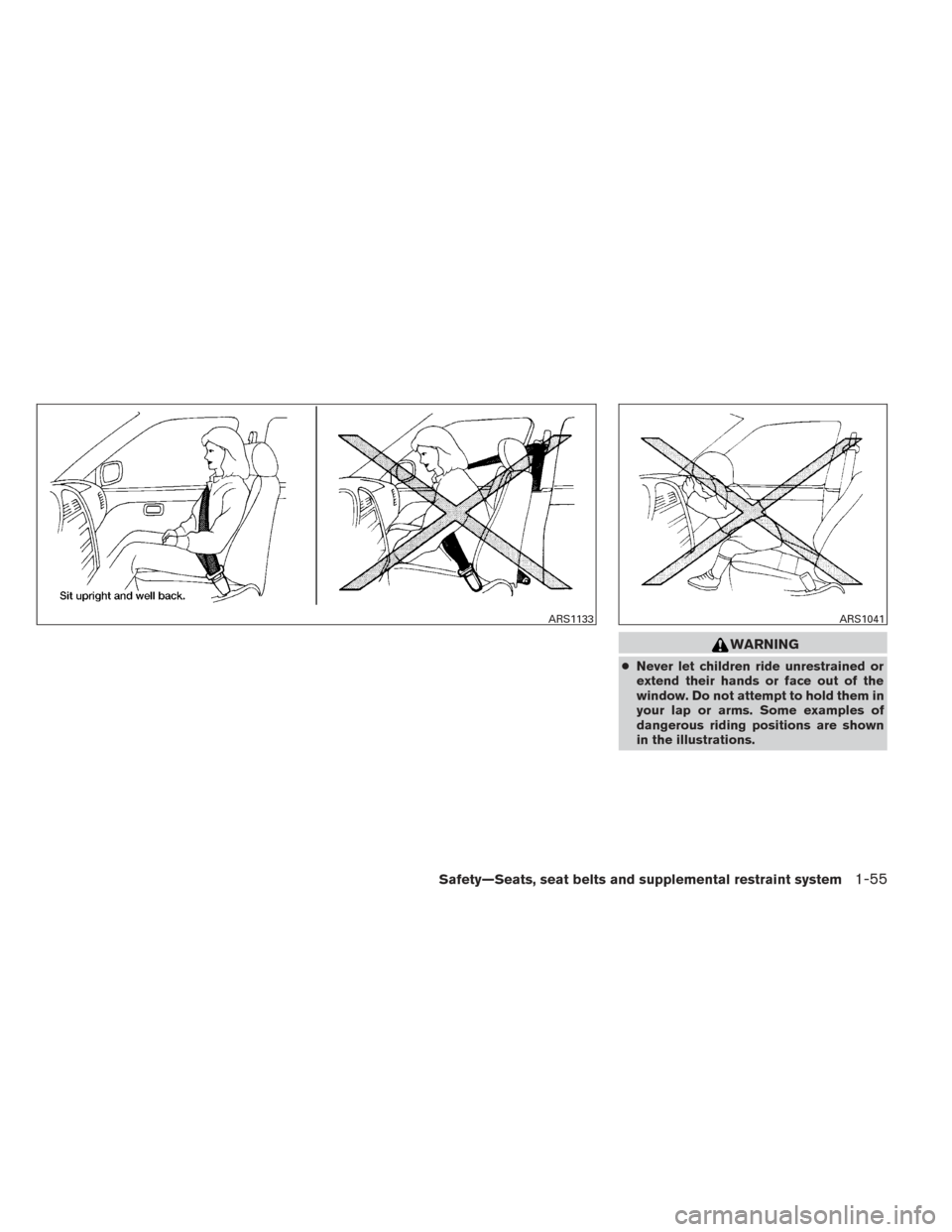
WARNING
●Never let children ride unrestrained or
extend their hands or face out of the
window. Do not attempt to hold them in
your lap or arms. Some examples of
dangerous riding positions are shown
in the illustrations.
ARS1133ARS1041
Safety—Seats, seat belts and supplemental restraint system1-55
Page 154 of 571
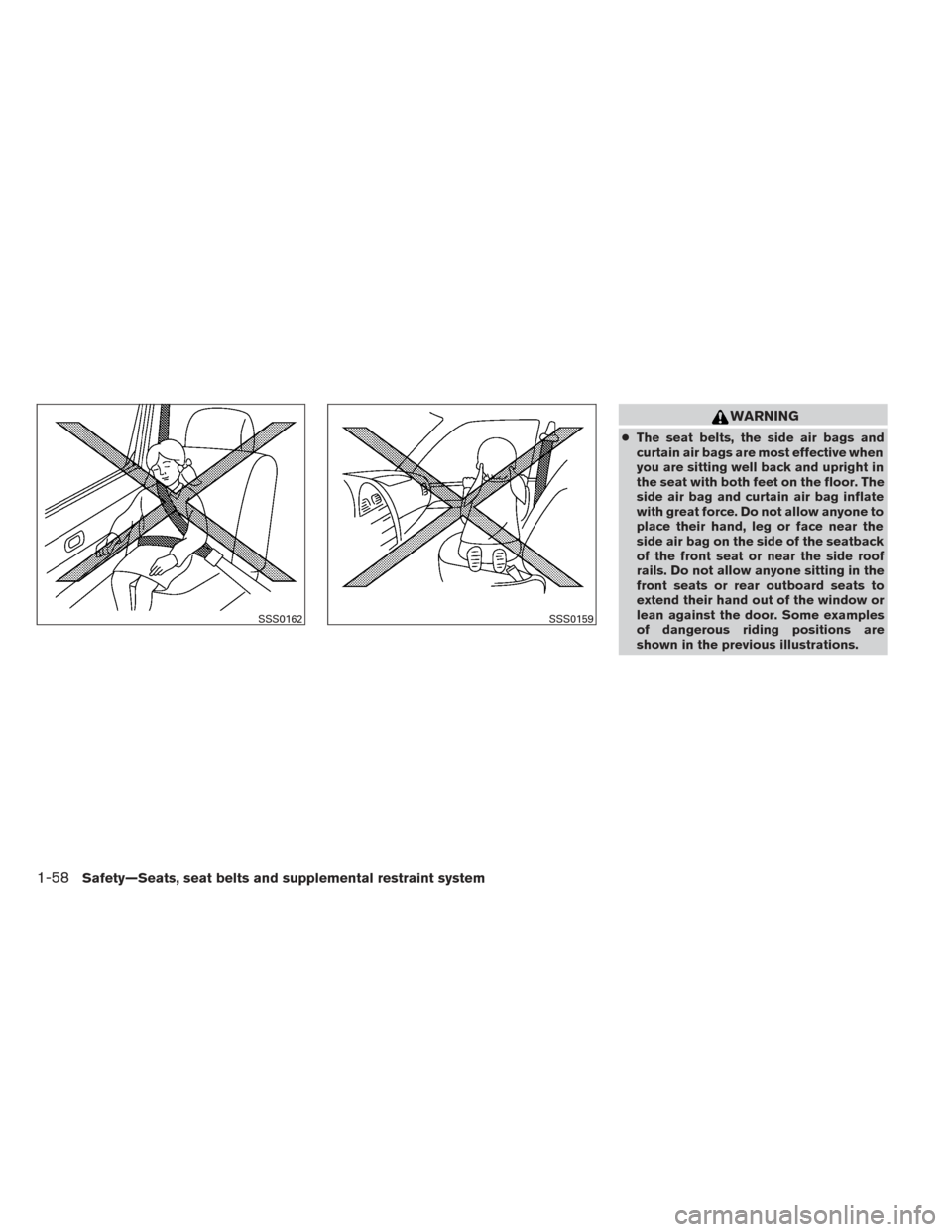
WARNING
●The seat belts, the side air bags and
curtain air bags are most effective when
you are sitting well back and upright in
the seat with both feet on the floor. The
side air bag and curtain air bag inflate
with great force. Do not allow anyone to
place their hand, leg or face near the
side air bag on the side of the seatback
of the front seat or near the side roof
rails. Do not allow anyone sitting in the
front seats or rear outboard seats to
extend their hand out of the window or
lean against the door. Some examples
of dangerous riding positions are
shown in the previous illustrations.
SSS0162SSS0159
1-58Safety—Seats, seat belts and supplemental restraint system
Page 166 of 571
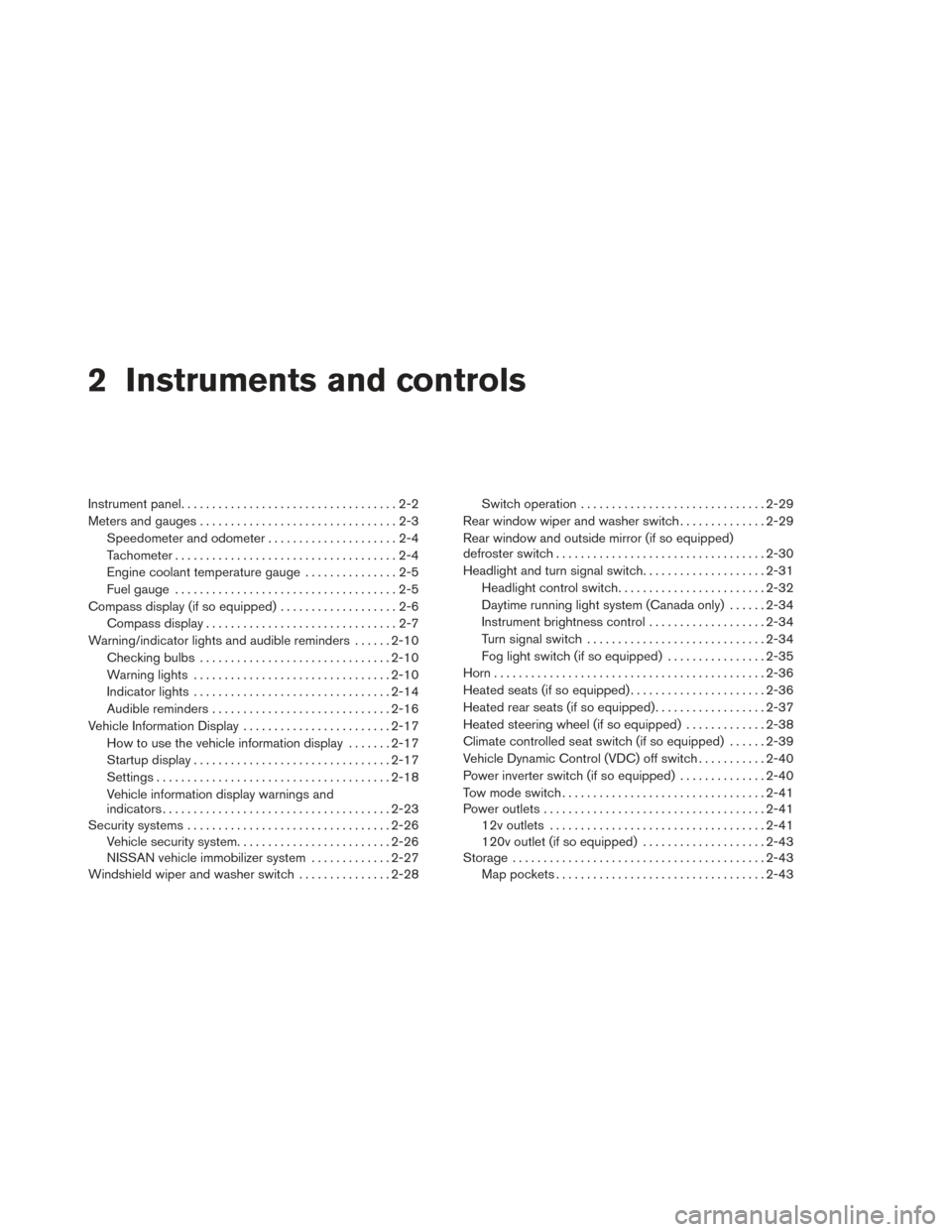
2 Instruments and controls
Instrument panel...................................2-2
Meters and gauges ................................2-3
Speedometer and odometer . . ...................2-4
Tachometer ....................................2-4
Engine coolant temperature gauge ...............2-5
Fuel gauge ....................................2-5
Compass display (if so equipped) ...................2-6
Compass display ...............................2-7
Warning/indicator lights and audible reminders ......2-10
Checking bulbs ............................... 2-10
Warning lights ................................ 2-10
Indicator lights ................................ 2-14
Audible reminders ............................. 2-16
Vehicle Information Display ........................2-17
How to use the vehicle information display .......2-17
Startup display ................................ 2-17
Settings ...................................... 2-18
Vehicle information display warnings and
indicators ..................................... 2-23
Security systems ................................. 2-26
Vehicle security system ......................... 2-26
NISSAN vehicle immobilizer system .............2-27
Windshield wiper and washer switch ...............2-28Switch operation
.............................. 2-29
Rear window wiper and washer switch ..............2-29
Rear window and outside mirror (if so equipped)
defroster switch .................................. 2-30
Headlight and turn signal switch ....................2-31
Headlight control switch ........................ 2-32
Daytime running light system (Canada only) ......2-34
Instrument brightness control ...................2-34
Turn signal switch ............................. 2-34
Fog light switch (if so equipped) ................2-35
Horn ............................................ 2-36
Heated seats (if so equipped) ......................2-36
Heated rear seats (if so equipped) ..................2-37
Heated steering wheel (if so equipped) .............2-38
Climate controlled seat switch (if so equipped) ......2-39
V
ehicle Dynamic Control (VDC) off switch ...........2-40
Power inverter switch (if so equipped) ..............2-40
Tow mode switch ................................. 2-41
Power outlets .................................... 2-41
12v outlets ................................... 2-41
120v outlet (if so equipped) ....................2-43
Storage ......................................... 2-43
Map pockets .................................. 2-43